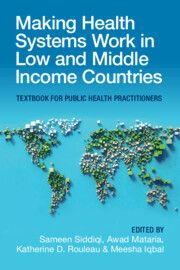 Making Health Systems Work in Low and Middle Income Countries
Making Health Systems Work in Low and Middle Income Countries Book contents
- Making Health Systems Work in Low and Middle Income Countries
- Reviews
- Making Health Systems Work in Low and Middle Income Countries
- Copyright page
- Dedication
- Contents
- About the Editors
- Contributors
- Preface
- Section 1 Analyzing Health Systems: Concepts, Components, Performance
- Chapter 1 Introduction to Health Systems
- Chapter 2 Health Systems Based on Primary Health Care
- Chapter 3 Universal Health Coverage and Health System Strengthening
- Chapter 4 Health System Governance
- Chapter 5 Financing Health Care
- Chapter 6 Health Workforce in Low and Middle Income Countries
- Chapter 7 The Pharmaceutical System and Its Components
- Chapter 8 Health Information Systems
- Chapter 9 The Organization and Management of Health Services
- Chapter 10 Health Services Delivery
- Chapter 11 Role and Contribution of the Community in Health System Strengthening
- Chapter 12 Performing Health Systems
- Chapter 13 Decision-Making Tools for Informed Decisions by Health Policymakers and Managers
- Chapter 14 Health Policy and Systems Research: The Role of Implementation Research
- Section 2 Transforming Health Systems: Confronting Challenges, Seizing Opportunities
- Index
- References
Chapter 1 - Introduction to Health Systems
Setting the Scene
from Section 1 - Analyzing Health Systems: Concepts, Components, Performance
Published online by Cambridge University Press: 08 December 2022
- Making Health Systems Work in Low and Middle Income Countries
- Reviews
- Making Health Systems Work in Low and Middle Income Countries
- Copyright page
- Dedication
- Contents
- About the Editors
- Contributors
- Preface
- Section 1 Analyzing Health Systems: Concepts, Components, Performance
- Chapter 1 Introduction to Health Systems
- Chapter 2 Health Systems Based on Primary Health Care
- Chapter 3 Universal Health Coverage and Health System Strengthening
- Chapter 4 Health System Governance
- Chapter 5 Financing Health Care
- Chapter 6 Health Workforce in Low and Middle Income Countries
- Chapter 7 The Pharmaceutical System and Its Components
- Chapter 8 Health Information Systems
- Chapter 9 The Organization and Management of Health Services
- Chapter 10 Health Services Delivery
- Chapter 11 Role and Contribution of the Community in Health System Strengthening
- Chapter 12 Performing Health Systems
- Chapter 13 Decision-Making Tools for Informed Decisions by Health Policymakers and Managers
- Chapter 14 Health Policy and Systems Research: The Role of Implementation Research
- Section 2 Transforming Health Systems: Confronting Challenges, Seizing Opportunities
- Index
- References
Summary
Well-performing health systems are critical for pursuing universal health coverage and for achieving health-related SDGs. It is important to grasp key concepts such as systems approach, analysis, and thinking before taking a deeper dive into health systems. Health systems can be described in broad or restricted terms. The most widely accepted definition includes all the institutions, actors, and activities whose primary purpose is to promote, restore or maintain health. There are many health system frameworks and models of which four have been reviewed - WHO’s Health System Conceptual Framework, Control Knobs Framework, Kielmann’s and Roemer’s Health System Models. No single framework addresses all aspects of a health system. It is more useful to know the strengths and limitations, and usefulness of each in achieving a specific objective such as for description and analysis, designing system reform, or evaluation. Interventions whether system-led, programmatic or those addressing health determinants are part of the wider health system and offer the best opportunity for improving health outcomes when addressed together.
Keywords
- Type
- Chapter
- Information
- Making Health Systems Work in Low and Middle Income CountriesTextbook for Public Health Practitioners, pp. 1 - 19Publisher: Cambridge University PressPrint publication year: 2022
References
- 1
- Cited by


